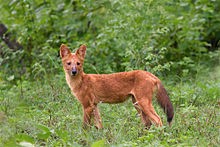Published on: January 26, 2023
Albinism in dholes
Albinism in dholes
Why in news? First for dholes (wild dogs), a partial albino dhole has been photo-documented in the Cauvery Wildlife Sanctuary.
Highlights
- This is not only the first-ever record of albinism in dholes from India but also from its entire distribution range in 11 countries.
- Record of the partial albino dhole was documented in the Sangama range of the Cauvery Wildlife Sanctuary
- Though albino dhole had never been recorded in the wild, a melanistic dhole had been recorded in Tamil Nadu.
- The first-ever record of honey badger for Karnataka from the same area in Cauvery Wildlife Sanctuary.
About Dholes
- It is a wild carnivorous animal and also known as Asian wild dogs or Indian wild dog
- Native to Central, South, East and Southeast Asia.
- In India, Myanmar, Indochina, Indonesia and China, it prefers forested areas in alpine zones and is occasionally sighted in plains regions.
- It’s IUCN status is Endangered
Conservation
- Protected under Schedule 2 of the Wildlife Protection Act, 1972.
- Appendix II in Convention on International Trade in Endangered Species of Wild Fauna and Flora (CITES)
- The first dhole conservation breeding centre at the Indira Gandhi Zoological Park (IGZP) in Visakhapatnam.
Distribution in India
- It occurs in most of India south of the Ganges, particularly in the Central Indian Highlands and the Western and Eastern Ghats.
- Present in Arunachal Pradesh, Assam, Meghalaya and West Bengal and in the Indo-Gangetic Plain’s Terai region.
- Dhole populations in the Himalayas and northwest India are fragmented.
About Cauvery Wildlife Sanctuary
- It is the protected area located in the Mandya, Chamarajanagar and Ramanagar districts of Karnataka, India
- The Cauvery River passes through its midst
- Ponnachi Betta is the highest mountain in the centre of the sanctuary
- Important places are forested central and eastern parts are the Hogenakal Falls, Mekedatu, and Sangam (confluence with the Arkavathi River).
- The sanctuary mainly consists of dry deciduous forest, southern tropical dry thorn and riverine forests.
- An important religious centre within the sanctuary is Muthathi Anjaneya temple.

